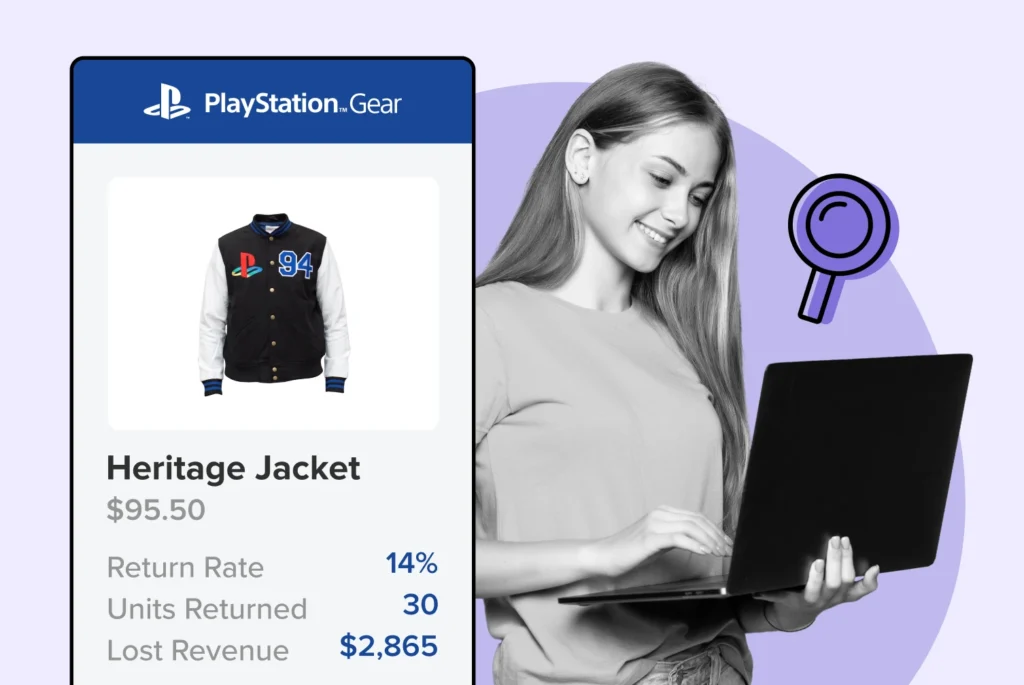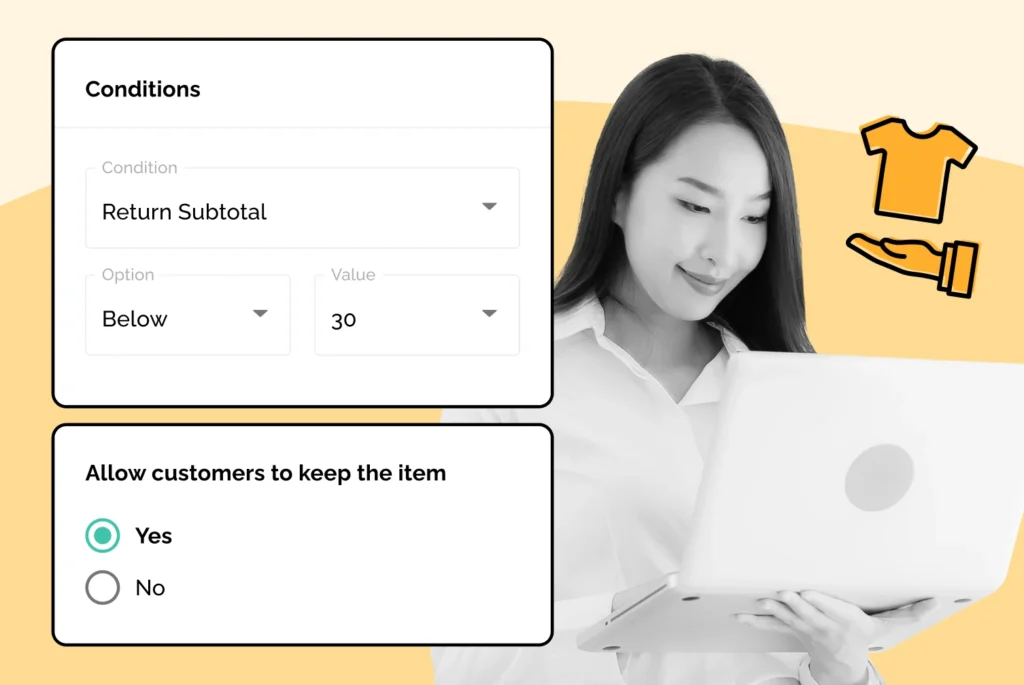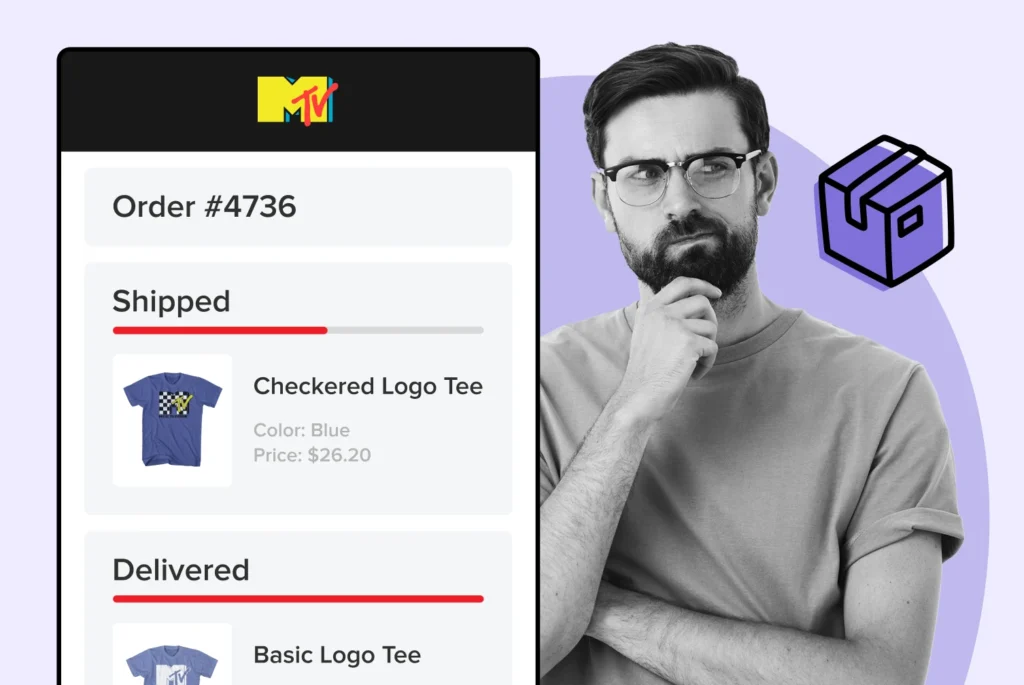Essential DTC Brand Metrics: Tracking Success in Direct-to-Consumer Business
Cutting to the heart of direct-to-consumer success: DTC brand metrics that will navigate your strategic decisions and drive business growth!
Boost customer experience and reduce support tickets
Realtime order and shipment tracking
Proactive order and shipping notifications
Predictive pre-purchase estimated delivery dates
Self-Serivce branded order tracking
Effortless experience delivered
Make returns profitable and delight customers
Flexibility to define any return destinations & conditions
Simplify returns for your customers and team
Incentivize exchanges over returns
Returns management made easy for your team
Understand why your customers are returning
Unify the online and the in-store experience
Hassle-free pickup experience for customers
In-Store Dashboard to keep operations streamlined
In-Store and Online orders unified
Drive foot-traffic to your stores
Boost customer experience and reduce support tickets
Realtime order and shipment tracking
Proactive order and shipping notifications
Predictive pre-purchase estimated delivery dates
Self-Serivce branded order tracking
Effortless experience delivered
Make returns profitable and delight customers
Flexibility to define any return destinations & conditions
Simplify returns for your customers and team
Incentivize exchanges over returns
Returns management made easy for your team
Understand why your customers are returning
Unify the online and the in-store experience
Hassle-free pickup experience for customers
In-Store Dashboard to keep operations streamlined
In-Store and Online orders unified
Drive foot-traffic to your stores
Find the answer to all your questions
Explore the most comon questions about WeSupply
Calculate the ROI that WeSupply can bring you
Request a no strings attached review of your current shopping experience and missed conversion opportunities
Take a step by step trip through our functionality to see how we can improve your ecommerce processes.
Read actionable articles on how to optimize your post-purchase experience and decrease support tickets
Get inspired by stories of how our customers implemented an effortless post-purchase experience
A Deep Dive into Top Companies' Order Tracking & Returns Strategy
Wondering if WeSupply is a good fit for you? Read through our use cases to see how we can help you increase conversion & improve CX!

Navigating the ‘returnless refunds’ model, customers may keep items and receive refunds without the usual return process. This shift has significant implications. Our exploration breaks down how these refunds operate, their potential for cost-saving, and the trade-offs they present for businesses and consumers alike.
Returnless refunds allow customers to receive a refund without the need to physically return the item, saving both customers and businesses time and money.
While returnless refunds can increase operational efficiency and customer satisfaction, they also present risks such as potential profit loss and policy abuse by customers.
Businesses need to carefully evaluate products and establish clear policies to determine which items are suitable for returnless refunds and implement measures to prevent fraud and abuse.
WeSupply revolutionizes the return process with its innovative returnless refunds, allowing customers to keep certain items, cutting costs and environmental impact. Its system includes customizable policies, automated returns, fraud prevention, and clear communication. With features like branded returns portals, automatic label generation, and QR code-based printerless returns, WeSupply offers a streamlined and efficient experience that prioritizes sustainability and customer satisfaction. Ready to transform your returns? Get Started with WeSupply Today!
The returnless refund policy is a groundbreaking approach that allows customers to receive a refund without the need to physically return the purchased product. It’s a policy that’s increasingly finding favor among both businesses and customers, for reasons we’ll explore in this blog post.
To appreciate the concept of returnless refunds, we need to first understand the evolution of return policies in e-commerce and the factors that led to their emergence.
In the world of e-commerce, return policies have evolved significantly to meet the changing needs of customers. The traditional brick-and-mortar model where customers could easily return unsatisfactory products has morphed into a more complex system for online retailers. Return processing in eCommerce can be costly in terms of time, money, and inventory management. This led to a need for a more customer-friendly approach to returns that also controlled costs and integrated returns into pricing strategies.
The COVID-19 pandemic served as a catalyst for this evolution. With the surge in online orders and returns, companies had to adapt their return policies to handle the increased volume. Some changes that have been made include:
Including interactive returns portals and pre-paid return labels to make the return process more convenient for customers
Extending the time frames for returns to accommodate delays
Online retailers, from department stores to electronics sellers, adapting their return policies to suit the online market
This evolution has seen many positive changes in return policies to better serve customers in the online shopping era.
Returnless refunds are essentially a policy where customers receive a refund without needing to return the purchased item. This policy is often adopted by sellers to avoid the hassle and expense of processing returns. Amazon, for instance, offers returnless refunds and allows sellers to set rules in their Seller Central account to trigger refunds based on various criteria like the number of days an item has been in inventory or the number of units sold. By providing a returnless refund option, sellers can streamline their operations and improve customer satisfaction.
When an Amazon returnless refund is initiated, Amazon automatically refunds the customer’s purchase price minus the cost of shipping and handling. The process typically takes about one to two business days after the refund request is made. While this policy has many advantages, it’s not without challenges. For instance, sellers can experience profit loss when excessive Amazon returnless refunds occur, especially if the refunds are for items bought with a discount or coupon.
There’s also the potential for scams, such as customers claiming non-receipt of items or returning damaged items without having to send them back. Despite these challenges, returnless refunds are a game-changer in the e-commerce industry, offering numerous advantages for both businesses and customers.
WeSupply has revolutionized the returns process by introducing returnless refunds, a method aimed at minimizing return expenses and boosting consumer contentment. By adopting a smart, criteria-based strategy, the system allows customers to retain products falling under a specific value limit, thereby bypassing the costs associated with return shipping and handling. This approach not only simplifies the returns procedure but also cultivates a favorable shopping experience, as it obviates the necessity for physical returns on certain items.
To effectively implement returnless refunds, there needs to be a solid operational workflow and a well-thought-out process to set returnless refund rules. These rules help safeguard the interests of the seller while ensuring a seamless refund experience for the customer. However, setting these rules is not a one-size-fits-all process; it requires strategic decision-making, careful consideration of potential risks, and a deep understanding of the business’s unique needs.
Now, we’ll compare traditional returns with returnless refunds and examine how to identify products and situations suitable for returnless refunds.
The traditional return process involves the customer returning the product to the retailer, who then inspects and restocks it. However, this process can be costly, with expenses such as return shipping costs, processing, and restocking sometimes equaling up to two-thirds of a product’s sale price. Moreover, items returned may not always be in a resalable condition, adding to the cost burden.
In contrast, returnless refunds offer a more streamlined approach. Customers receive refunds without having to return the items, making it a more convenient and cost-effective solution. This is particularly advantageous for items that are bulky or challenging to ship. Retailers also benefit from this policy as it eliminates costs associated with traditional returns and expedites the refund process. Moreover, returnless refunds are more environmentally friendly as they reduce waste and eliminate carbon emissions associated with return shipping.
However, while returnless refunds offer numerous advantages, they also have potential drawbacks. For instance, sellers risk taking financial hits as customers keep the products. There’s also the risk of policy abuse, with customers potentially exploiting the system to get refunds without returning the items. Despite these challenges, returnless refunds are gaining popularity, particularly for single-use or no-resale items that are usually not resalable and would require disposal if returned.
When deciding to offer returnless refunds, it’s crucial to identify which products and situations are suitable. Amazon’s platform allows sellers to set up returnless refunds for specific products and SKUs that meet eligibility criteria. For instance, single-use or non-resalable products like hygiene or beauty items are often ideal for returnless refunds, as there’s no potential to resell these returned items.
However, sellers need to be cautious as returnless refunds can potentially lead to profit loss. For example, if a customer initiates multiple refunds for the same purchase without returning the items, sellers receive the product’s price minus shipping and handling costs. Additionally, sellers do not receive compensation for the discounted amount if a returnless refund is initiated on an item bought with a coupon or discount. Therefore, it’s crucial to set up rules specifying conditions like inventory duration or units sold to mitigate these risks.
While returnless refunds offer multiple benefits, they can also be misused. To prevent abuse, sellers need to set frequency limits or thresholds related to inventory days or units sold. This ensures that returnless refunds are given judiciously and not exploited by customers to get refunds without genuine reasons.
Moreover, businesses can leverage technology to monitor potential abuse of returnless refunds. For instance, customer relationship management (CRM) systems can flag customers who request excessive refunds, helping businesses take timely action. Retailers can also utilize artificial intelligence to determine when a returnless refund is applicable, considering factors such as a customer’s purchase history, return processing costs, and the store’s returnless refund limit. These measures can help businesses balance customer satisfaction with the need to protect against rising costs.
WeSupply is adept at enhancing the operational efficiency of ecommerce returns with its returnless refund rules, aiming to streamline the process while safeguarding the interests of businesses. Key features of WeSupply’s approach include:
Custom Return Policies: Tailor your return strategies to fit your business needs, managing final sale items, return window lengths, and return request approvals with ease.
Keep the Item: Encourage sustainability by allowing customers to keep items that cannot be resold, reducing waste and eliminating the need for return shipments.
Policy Enforcer: Automate the approval, rejection, or manual review of returns and exchanges based on predefined conditions, simplifying complex return policies.
Reduce Returns Fraud Rate: Leverage an intelligent fraud prevention system to identify and block customers attempting to abuse the return policy, and integrate existing block lists to prevent fraudulent returns.
By focusing on these key areas, WeSupply offers a comprehensive solution that not only minimizes unnecessary logistics but also fosters trust and loyalty among consumers. Discover a Smoother Return Process – Book Your WeSupply Demo Today!
Increase return policy compliance
Book a quick call with our experts to see how WeSupply can help your customers understand what they can and cannot return. This will result in fewer ineligible returns overall.
A Case Study about Evereve: Evereve faced significant challenges in handling the high volume of orders and returns in the fashion industry, a process plagued by manual efforts, lack of visibility, and inefficiency. By partnering with WeSupply and integrating their Magento & Custom API solutions, Evereve revolutionized their returns process. Automation and centralization have now empowered them with proactive, self-service, and flexible return options, transforming returns into opportunities for increased sales and customer loyalty. This strategic overhaul has led to substantial cost savings, improved return management, and a seamless customer experience, culminating in enhanced employee productivity and performance. Read the full case study to explore how Evereve leveraged WeSupply to optimize their returns process and turn challenges into opportunities for growth.
Returnless refunds offer a plethora of advantages for businesses, including:
Significantly reducing costs associated with processing returns
Enhancing the customer experience
Increasing customer loyalty
Giving businesses a competitive edge
Contributing to environmental sustainability.
It’s worthwhile to explore these benefits in more detail.
One significant advantage of returnless refunds is cost reduction. By eliminating the need to handle returns, retailers can save on logistics costs. This is particularly beneficial for low-cost items for which the cost of processing returns could exceed the item’s resale value. Heavy or bulky items that are costly to ship can also benefit from returnless refunds.
Moreover, returnless refunds can lead to operational efficiencies. By eliminating expenses related to return shipping fees and shipping cost, as well as:
shipping
inspection
restocking
potentially refurbishing returned items
retailers can focus their resources on other crucial aspects of their business. This allows them to operate more efficiently and potentially increase their overall profitability.
WeSupply boosts ROI by driving cost reductions and enhancing operational efficiency. Its tools streamline supply chains and inventory management, enabling businesses to cut expenses and improve operations. Ready to uncover your savings? Use our ROI Calculator now for immediate insights.
Returnless refunds can significantly enhance customer satisfaction. The convenience of not having to return a product for a refund makes the return process less cumbersome for customers, improving their overall shopping experience. Indeed, a convenient return experience can positively influence a customer’s decision to shop with a retailer again.
Moreover, customer loyalty can be fostered through returnless refunds. Customers who have a positive return experience are likely to become repeat customers, thus improving retention. This can be a significant advantage, particularly in today’s competitive e-commerce landscape, where customer retention can be as crucial as acquiring new customers.
In today’s fiercely competitive e-commerce landscape, businesses need to differentiate themselves to gain a competitive edge. One option for setting your business apart from others is to offer returnless refunds. This can help attract and retain customers looking for a hassle-free shopping experience. By providing a hassle-free refund experience, businesses can set themselves apart from competitors and attract more customers.
Moreover, returnless refunds can also help businesses retain existing customers. Customers appreciate the convenience and perceived value of returnless refunds, which can lead to increased sales and referrals. Retail giants like Amazon and Walmart have realized these benefits and are already utilizing returnless refunds to streamline their return processes.
Returnless refunds not only offer financial benefits but also contribute to environmental sustainability. By eliminating the need for return shipping, returnless refunds can reduce carbon emissions and waste associated with additional packaging and transportation. This aligns with sustainable business practices and can improve a business’s green credentials.
Furthermore, returnless refunds can help:
Prevent the disposal of returned items that are not viable for resale
Reduce the amount of waste that ends up in landfills
Donate returned products to local communities or partner with resale companies to give these items a second life
This supports sustainability and reduces waste even further.
WeSupply champions environmental stewardship through its innovative Green Returns initiative, encouraging sustainable practices in the ecommerce sector. By allowing customers to keep items that would otherwise contribute to landfill waste, WeSupply significantly reduces unnecessary environmental impact. This approach not only cuts down on waste but also offers cost savings on return labels, processing time, and expenses, enabling quicker refunds. Moreover, its flexibility allows for configuration based on specific products or return values, underscoring WeSupply’s commitment to sustainability and efficiency in the return process.
Once you understand the benefits of returnless refunds, you might consider implementing such a policy in your own business. Crafting a returnless refund policy is not a one-off task; it requires careful planning and strategic decision-making. You need to ensure clear and transparent communication so that your customers understand the policy.
Furthermore, the refund process should be simple to enhance the customer experience. We will explore these aspects more thoroughly.
The first step in implementing a returnless refund policy is ensuring clear and transparent communication. This involves:
Using simple language
Making the policy easily accessible on various customer-facing platforms
Making sure your returnless refund policy is easy to locate by linking to it from each product and order page on your website
This can help enhance customer understanding and prevent confusion.
Also, provide a scannable list detailing eligible products, item conditions, and information on shipping fees. Explain how refunds will be issued, such as crediting the original payment method. Providing an FAQ section about the returnless refund policy can be useful for addressing common customer queries. And don’t forget to update your company’s return policy and share thorough information with both customers and internal teams.
WeSupply stands out for its commitment to clear and transparent communication, particularly in managing returns. This approach is pivotal in enhancing customer experience by simplifying the return process and reducing inquiries, thereby acting like a 24/7 customer support system. Key features that underline WeSupply’s transparent communication include:
Clarity on Non-Returnable Items: Distinctly identifies items that cannot be returned, such as final sale products, non-resellable items, goods outside the return window, and purchases by blocklisted customers, eliminating confusion and unnecessary communication.
Reduced Customer Inquiries: By facilitating the start of returns or exchanges anytime, providing detailed return instructions, and issuing regular updates on return status, WeSupply reduces the need for direct customer inquiries.
Comprehensive Return Process Updates: Offers return status notifications, return delivery confirmation, detailed return instructions, and refund confirmations to keep the customer fully informed at every step.
By focusing on these aspects, WeSupply not only streamlines the return process but also fosters trust and satisfaction among customers through its transparent practices.
Simplifying the refund process is crucial to enhancing the customer experience. This can be achieved through various means. For instance, offering an online customer portal where clients can view orders and print return labels can help streamline the refund process. Also, responding promptly to refund requests and tracking response times can improve the customer’s experience and ensure they remain satisfied with the service.
Furthermore, leverage technology to make the refund process more efficient. For instance, automation of the return process, including the generation of return labels, can save time and reduce the workload on customer service teams. Proactive communication and regular updates on the status of returns can also reduce customer anxiety and enhance the post-purchase experience.
WeSupply significantly simplifies the refund process, prioritizing a seamless customer experience that can bolster customer loyalty. By integrating features designed to streamline returns and enhance user interaction, WeSupply offers a straightforward and efficient approach to managing refunds. Key features include:
Automatic Return Labels: Enables customers to generate return labels automatically, ensuring convenience even when staff are unavailable.
Printerless Returns via QR Code: Improves customer experience by allowing for printerless returns, with customers receiving a QR code instead of a traditional PDF for shipping labels, facilitating an easier return process.
Proactive Customer Support: Acts as an around-the-clock customer support service, with WeSupply providing clear instructions for returns, regular updates on return status, delivery confirmations, and refund notifications.
These features collectively reduce customer inquiries and foster a positive experience, making the refund process as effortless as possible for both customers and retailers.
We’ve discussed how returnless refunds can streamline operations, reduce costs, and enhance customer satisfaction. But the benefits of returnless refunds extend beyond these areas. They can shape customer relationships, influence shopping behavior, and even shape the future of e-commerce.
We will examine these aspects further.
Implementing returnless refunds can significantly shape customer relationships. It can increase customer retention and encourage repeat purchases. This is especially important as acquiring a new customer can cost five times more than retaining an existing one. By offering a hassle-free return experience, you can foster customer loyalty and ensure your business stays competitive in the long run.
Furthermore, returnless refunds can enhance customer satisfaction. A positive return experience can make customers more likely to shop with a retailer again, thus improving retention. This can be a significant advantage in today’s competitive e-commerce landscape, where customer retention can be as crucial as acquiring new customers.
Customer testimonials play a crucial role in influencing potential customers’ decisions. When customers have positive experiences with returnless refunds, they are more likely to share their experiences, encouraging others to purchase from the retailer. By analyzing a customer’s purchase history, these testimonials can significantly impact shopping behavior, leading to increased sales and customer loyalty.
Moreover, a positive return experience can enhance the perceived quality of the retailer, fostering trust and increasing consumer purchase intentions. This can be particularly beneficial for online retailers, where customers can’t physically inspect products before purchasing. By offering returnless refunds, businesses can alleviate customers’ concerns over potential product returns, making them more confident in their purchasing decisions.
While returnless refunds offer numerous benefits, they also come with their share of challenges. One of the main challenges is preventing fraud and policy abuse. Businesses need to strike a balance between offering a hassle-free return experience and protecting their interests.
Let’s discuss strategic approaches to fraud prevention and how businesses can navigate these challenges.
Balancing the flexibility of returnless refunds with measures to protect your business can be tricky. Businesses need to craft clear, fair, and enforceable return guidelines to deter return abuse while ensuring customer satisfaction. They can also offer rewards and incentives to genuine customers to discourage return abuse and foster customer loyalty.
In extreme cases of return fraud, businesses can consider the following actions to prevent further losses:
Blacklisting repeat offenders
Leveraging technology to monitor potential abuse of returnless refunds
Using customer relationship management (CRM) systems to flag customers who request excessive refunds, helping businesses take timely action.
Preventing fraud and policy abuse requires strategic approaches. Monitoring return data can help identify customers who are creating more costs than revenue, potentially leading to blacklisting if necessary. Businesses can also leverage technology like artificial intelligence to monitor potential abuse of returnless refunds.
Implementing a returns management system that can automatically identify and block policy abusers can also help prevent exploitation by customers with fraudulent intentions. Additionally, businesses can require customers to provide photographic evidence of the items’ condition before processing returns. This can aid in avoiding fraudulent returns.
WeSupply leverages an advanced automated system to combat returns fraud and policy abuse effectively. By employing an intelligent fraud prevention system, it identifies and automatically blocks customers who misuse the return policy, such as making purchases for temporary use or without the intent to keep the items. Additionally, WeSupply can integrate with existing “block lists” to further prevent known abusers from exploiting the system. This robust approach ensures a secure and fair environment for both the business and its genuine customers, safeguarding against financial losses and maintaining trust.
While returnless refunds offer numerous benefits, they may not be suitable for every business model. Different product types may require unique return policies that address their specific needs and customer concerns on a case by case basis, including the possibility of a full refund.
Therefore, it’s crucial for businesses to adapt their return policies based on their specific business models and the nature of the products they sell.
When it comes to high-value vs. low-cost items, a tailored approach is needed for implementing returnless refunds. For high-value items, a traditional return policy can be more suitable as the cost of processing returns is less likely to exceed the item’s resale value. However, returnless refunds can be more beneficial for low-cost items, where the cost of processing returns could exceed the item’s resale value.
The decision to offer returnless refunds for high-value or low-cost items also depends on the nature of the items. For example, heavy or bulky items that are costly to ship can benefit from returnless refunds. Similarly, items that cannot be resold, such as certain types of clothing or hygiene products, are also suitable candidates for returnless refunds.
WeSupply implements a nuanced approach to managing returns by differentiating between high-value and low-cost items, optimizing both customer satisfaction and cost efficiency. Through a smart, condition-based strategy, customers are permitted to retain items under a specified value threshold. This approach effectively reduces return costs by eliminating the need for shipping and handling of low-cost items, while simultaneously enhancing the customer experience by simplifying the returns process. This tailored method strikes a balance between operational efficiency and customer goodwill, ensuring a positive impact on both the business and its clientele.
Different types of products and services may require special considerations when implementing returnless refunds. For instance, perishable goods, electronics, or apparel may require unique return policies that address their specific needs and customer concerns. Sellers can define specific criteria for products eligible for returnless refunds on Amazon, setting rules for entire product categories or individual items.
However, there are certain limitations to the implementation of returnless refunds. For instance, Amazon’s returnless refund system excludes certain types of items, such as:
Handmade and non-physical items
Sexual wellness products
Dental and medical supplies
Certified pre-owned watches
Hazardous goods
Custom articles
Therefore, it’s crucial for businesses to carefully assess their product types and categories before deciding to implement returnless refunds.
The future of returnless refunds looks promising. With the continued growth of e-commerce and the increasing return rates, retailers are rethinking their return policies. Returnless refunds are becoming more prominent, especially during the pandemic, as they helped alleviate the load on shipping services.
Is a no-return policy ideal for your business? Evaluating the strategic value of returnless refunds and considering key factors can help you make this decision.
The strategic value of returnless refunds lies in their ability to reduce costs for retailers, streamline operations, and enhance the customer experience. They can significantly cut logistics and handling costs associated with traditional returns, allowing businesses to allocate resources more efficiently elsewhere in their business. This, in turn, can increase overall profitability.
Beyond immediate cost savings, returnless refunds have the potential to:
Elevate customer lifetime value by enhancing the customer experience
Increase customer loyalty
Give businesses a competitive edge
Contribute to environmental sustainability
Retail giants like Amazon and Walmart are already leveraging these benefits and utilizing returnless refunds to streamline their return processes.
Deciding whether a no-return policy is right for your business involves careful consideration of various factors. You need to weigh the importance of customer retention against the costs associated with return processing. It’s also important to consider the types of products you sell. For instance, returnless refunds may not be suitable for high-value items but could be beneficial for low-cost items that are costly to return.
However, implementing a no-return policy also comes with challenges. For instance, it may decrease sales if it leads to a lower conversion rate as customers may hesitate to purchase without the option of returns. Also, in certain jurisdictions, no-return policies may be illegal and could conflict with state laws or consumer protection regulations. Therefore, it’s crucial to consider all these factors before deciding to implement a no-return policy.
In conclusion, returnless refunds present an innovative approach to managing returns in e-commerce. They offer numerous benefits, from reducing costs and streamlining operations to enhancing customer satisfaction and fostering loyalty. However, implementing returnless refunds requires careful planning and strategic decision-making, including setting clear guidelines, identifying suitable products and situations, and preventing fraud and policy abuse. As we move into the future, returnless refunds are likely to become an integral part of e-commerce, shaping customer relationships, influencing shopping behavior, and contributing to the sustainability of our planet.
WeSupply has transformed the returns landscape with its innovative approach to returnless refunds, seamlessly blending cost-efficiency with enhanced customer satisfaction. By allowing customers to keep items of certain values, WeSupply eliminates the financial and environmental costs of return shipping, fostering a positive and sustainable shopping experience. This strategy is supported by customizable return policies, automated decision-making on returns and exchanges, and an intelligent system to prevent fraud, all while ensuring clear communication and a streamlined process for both high-value and low-cost items. With its focus on reducing waste, simplifying returns, and combating fraud, WeSupply not only prioritizes operational efficiency but also champions environmental stewardship and customer loyalty. Eager to enhance your returns process and customer satisfaction? Get Started with WeSupply Today!
Create custom return policies
Book a quick call with our experts to see how WeSupply can help you take control of returns by creating custom policies to handle them all easily. You get to decide how you want to handle final sale items, return window lengths, return request approvals, and more.
The returnless resolution rule allows you to issue a refund or replacement without requiring the buyer to return the product, either automatically or through communication with the buyer. It provides flexibility for handling customer returns.
Returnless refunds are a policy where customers can get a refund without having to return the purchased item, which is often used by sellers to simplify the return process and reduce costs.
Returnless refunds benefit businesses by reducing costs, streamlining operations, enhancing customer satisfaction, increasing customer loyalty, providing a competitive edge, and contributing to environmental sustainability. These benefits can have a positive impact on the overall success of a business.
WeSupply utilizes a smart, condition-based strategy that identifies items below a certain value threshold as eligible for returnless refunds. This approach balances cost efficiency with customer satisfaction, ensuring a smooth and favorable shopping experience.
Yes, WeSupply allows you to tailor your return strategies to fit your business needs. You can manage final sale items, return window lengths, return request approvals, and more, providing flexibility to meet specific operational requirements.
WeSupply has an intelligent fraud prevention system that detects and blocks customers attempting to abuse the return policy. It can also sync with existing “block lists” to prevent known abusers from making returns, safeguarding your business against financial losses.
Yes, WeSupply does have an official Shopify App. You can download and begin to integrate it with your Shopify store.
Yes, WeSupply has an official extension for Magento. The WeSupply x Magento integration allows for automating order tracking experiences, reducing customer inquiries, automating shipping email and SMS notifications, and providing a fully branded order tracking experience
Yes, WeSupply has an official BigCommerce App. You can integrate WeSupply with your BigCommerce store to improve your post-purchase customer experience.

Learn How To Create Successful Post Purchase Email Campaigns
Build an effective post-purchase email flow that helps you increase customer satisfaction and drive revenue growth!
Consumers seek the best deals on:
Cutting to the heart of direct-to-consumer success: DTC brand metrics that will navigate your strategic decisions and drive business growth!

Metrics to track, why they’re significant, and how they can guide your strategies toward minimizing returns and enhancing customer loyalty!

Let’s unpack effective strategies to influence return behavior that balance customer needs with business viability!

Let’s discover the indispensable benefits of such a dashboard, delving into the must-have features, vital metrics, and seamless integrations!

What are returnless refunds? Get ready to navigate the pros and cons of this revolutionary approach to returns!

Let’s discover the golden rules for financial savvy: optimizing cash flow, cutting needless costs, and strategic planning!

This article provides actionable insights for businesses ready to embark on a sustainable packaging journey!

Let’s navigate the complexities of inventory, shipping policies, and customer communication with confidence!

Let’s examine the underlying factors of return trends and identify sustainable practices crucial for the future of retail!